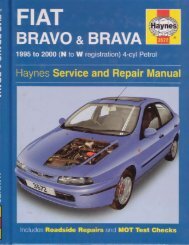001-055 Alfa 156 GB - Alfa Romeo serviss
001-055 Alfa 156 GB - Alfa Romeo serviss
001-055 Alfa 156 GB - Alfa Romeo serviss
You also want an ePaper? Increase the reach of your titles
YUMPU automatically turns print PDFs into web optimized ePapers that Google loves.
CORRECT USE OF THE CAR<br />
194<br />
DRIVING IN THE RAIN<br />
Rain and wet roads can be dangerous.<br />
If the road is wet, the traction between<br />
wheel and asphalt is greatly reduced, thus<br />
increasing the stopping distance and decreasing<br />
road holding.<br />
Here are few suggestions in the case of<br />
rain:<br />
– Reduce speed and keep further back<br />
from the vehicle in front.<br />
– If it is raining particularly heavily, visibility<br />
is also reduced. In these cases, switch<br />
on the dipped headlights even if it is still daylight<br />
so you can be seen more easily.<br />
– Do not drive through puddles at speed<br />
and hold on tightly to the wheel if you do: a<br />
puddle taken at high speed might cause you<br />
to lose control of the car (“aquaplaning”).<br />
– Position the ventilation controls for<br />
demisting (see chapter “Getting to know<br />
your car”), to prevent visibility from worsening.<br />
– Routinely check the conditions of the<br />
windscreen wiper blades.<br />
DRIVING IN THE FOG<br />
– If fog is very thick, avoid travelling<br />
where possible. If travelling with mist,<br />
ground fog or the possibility of fog banks:<br />
– Drive at moderate speed.<br />
– Also in the day turn on the dipped-beam<br />
headlights, rear fog guards and front fog<br />
lights. Do not use the main beam headlights.<br />
WARNING On stretches of road with<br />
good visibility, switch off your rear foglights;<br />
the brightness of these lights could annoy<br />
the people travelling in the cars behind.<br />
– Remember that fog also involves wet<br />
asphalt, thus greater difficulty in all types of<br />
manoeuvres and longer stopping distances.<br />
– Keep well away from the vehicle in<br />
front.<br />
– Where possible avoid sudden changes<br />
in speed.<br />
– Possibly avoid overtaking other vehicles.<br />
– If the vehicle is forced to stop (faults,<br />
impossibility to continue due to poor visibility,<br />
etc.), firstly try to pull off the road.<br />
Then turn on the hazard warning lights and,<br />
if possible the dipped beam headlights. Rythmically<br />
sound the horn if you note another<br />
car coming.<br />
MOUNTAIN DRIVING<br />
– When driving downhill, use the engine<br />
braking by engaging a low gear, to prevent<br />
the brakes from overheating.<br />
– Never coast downhill with the engine off<br />
or in neutral and especially not with the ignition<br />
key removed.<br />
– Drive at moderate speed and avoid “cutting”<br />
corners.<br />
– Remember that overtaking up hill is<br />
slower and therefore requires a greater<br />
length of clear road. If you are being overtaken<br />
on a hill, move over to enable the<br />
other vehicle to pass in safety.

















